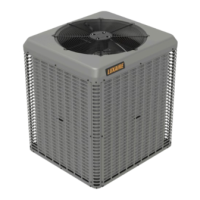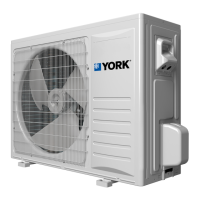Measuring indoor airflow
To determine the rated airflow for a specific
match, refer to the technical literature available at
www.simplygettingthejobdone.com. When attempting to
match this air flow, select the lowest possible speed tap,
measure the actual flow, and adjust as necessary.
About this task:
To measure actual airflow, it is not an acceptable method
to just check the jumper pin setting tables and assume 0.5
in. W.C total external static pressure.
To determine indoor airflow, follow these steps:
1. On a gas furnace or single-piece air handler,
measure the static pressure with a manometer
between the filter and return air opening of the
indoor equipment. On a modular air handler,
measure the return air static pressure between the
indoor coil and entering air side of the modular air
handler.
2. Perform a OR b.
a. On a single-piece or modular air handler, take a
second reading in the supply air ductwork leaving
the indoor equipment.
b. On a gas furnace, take a second reading after the
heat exchanger, but before the indoor coil.
3. Add the negative return static to the positive
supply static to determine the total system static
pressure. Treat the negative return static as a
positive pressure (even though it is a negative
reading). If there is static pressure on the blower
return (for example, -0.1 in. W.C.), add it to a supply
static (0.4 in. W.C.) that equals the total system
static pressure (0.5 in. W.C.).
4. Compare this value to the indoor blower
performance charts, ensuring air flow is between
350 CFM to 450 CFM per ton of cooling.
Charging the unit
CAUTION
Always charge in liquid form. Take care not to slug the
compressor.
The factory charge in the outdoor unit includes enough
charge for the unit, 15 ft (4.6 m) of refrigerant piping, and
the smallest indoor coil or air handler match-up. Some
indoor coil or air handler matches may require additional
charge.
CAUTION
Compressor damage will occur if system is improperly
charged. On new system installations, charge system
according to the Tabular Data Sheet for the matched
coil and follow guidelines in this instruction.
Refer to the Tabular Data Sheet provided in the customer
booklet for the unit for charge requirements. You must
permanently mark the total system charge on the unit
data plate.
CAUTION
Do not leave the system open to the atmosphere. Unit
damage could occur due to moisture being absorbed
by the POE oil in the system. This type of oil is highly
susceptible to moisture absorption.
Determining the total system charge
1. Determine the outdoor unit factory charge using
the Tabular Data Sheet.
2. Determine the indoor coil adjustment (if any) using
the Tabular Data Sheet.
3. Calculate the additional charge for the refrigerant
piping using the Tabular Data Sheet if the line
length is greater than 15 ft (4.6 m).
4. Note that the total system charge = item 1 + item 2
+ item 3.
5. Check the unit against the pressure value listed on
the cooling chart on the unit or the appropriate
heat charging chart in this manual. Make any
adjustment necessary.
6. Add or subtract refrigerant to obtain the pressure
listed on the charging chart. Make sure to adjust
the total system charge by the amount added or
removed to obtain the charging chart pressures.
Permanently mark the unit data plate with the total
amount of refrigerant in the system.
R-410A Outdoor Split-System Heat Pump Installation Manual - YH2E / THE2 / RHP143 Series14
Johnson Controls Ducted Systems

